
Food we eat should nourish our bodies and make us feel full of the energy we need to enjoy life. Food is central to healthy living. The best things to eat for health promotion are low in sugar, not processed, and mostly made at home. Food should be eaten in as close to its natural state as possible.
Science is clear that the Mediterranean diet is associated with healthy aging and longer lifespans. The Mediterranean diet prevents diabetes. In people with diabetes, a Mediterranean diet helps control blood sugars. People who eat a Mediterranean diet are less likely to have a heart attack or stroke. They are also less likely to develop Alzheimer’s disease or dementia, or be diagnosed with cancer (including breast cancer).

The Mediterranean diet includes the following food categories in order of most important to least important to good health:
 Fresh or frozen vegetables
Fresh or frozen vegetables
 Fresh or frozen fruits
Fresh or frozen fruits
 Whole grains
Whole grains
 Beans
Beans
 Nuts
Nuts
 Seeds
Seeds
 Fish
Fish
 Poultry (turkey, chicken)
Poultry (turkey, chicken)
 Dairy products (full fat)
Dairy products (full fat)
 Olive oil and healthy fats
Olive oil and healthy fats
 Honey
Honey
 Optional: Low to moderate amounts of wine (preferably red wine)
Optional: Low to moderate amounts of wine (preferably red wine)
The following items are NOT included in a Mediterranean diet because they are bad for your health:
 Sugary sweets like cookies, candy, cake, pie, and ice cream
Sugary sweets like cookies, candy, cake, pie, and ice cream
 Processed foods (i.e., food that comes in packages)
Processed foods (i.e., food that comes in packages)
 Food you can get as take out like at fast food restaurants
Food you can get as take out like at fast food restaurants
 Soda (not even diet soda)
Soda (not even diet soda)
 Store-bought fruit juice
Store-bought fruit juice
 Canned fruit
Canned fruit
 Beer
Beer
 Liquor
Liquor
 Fried food
Fried food
 Ready-made salad dressings
Ready-made salad dressings
 Red meat including beef, pork, and game like venison, buffalo, or rabbit
Red meat including beef, pork, and game like venison, buffalo, or rabbit
The following items are NOT included in a Mediterranean diet but ARE included in this weight loss program:
•Coffee
•Tea
•Dark chocolate
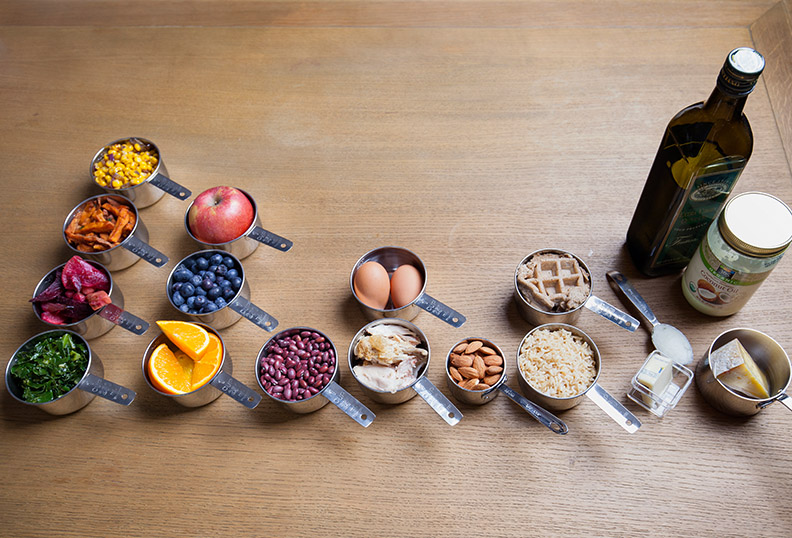
Diet quality is important to ensure you eat all of the nutrients needed to be healthy.
Quality foods contribute to health whether or not you lose weight. We categorize high-quality food to help you optimize the health benefits you get from food you eat. Maybe you’ve tasted all of these foods. Maybe some of them are unfamiliar. Eating a wide variety of food and being willing to try new foods will help you on your path to finding the highest quality foods you like, can regularly prepare on your own, and share with family and friends.
Food category |
Examples |
Vegetables |
Beets, Brussels sprouts, cabbage, carrots, cauliflower, cucumbers, garlic, ginger, lettuce, mushrooms, onions, parsnips, peas, peppers, pumpkin, squash, sweet potatoes, tomatoes, turmeric, turnips, yams, zucchini |
Leafy green vegetables |
Arugula (also called rocket), beet greens, bok choy, broccoli, carrot greens, collard greens, kale, mizuna, mustard greens, spinach, Swiss chard, turnip greens |
Fruits |
Apples, avocado, bananas, berries, dates, figs, grapes, melons, oranges, peaches, pears, pineapples, raisins |
Nuts |
Almonds (including almond milk), cashews, chia seeds, flax seeds, hazelnuts (including hazelnut milk), macadamia nuts, peanuts, pecans, pine nuts, pumpkin seeds, walnuts |
Beans |
Black beans, calypso, garbanzo beans (also called chickpeas), hummus, kidney beans, lentils, navy beans, pinto beans, soy milk, tempeh, tofu |
Whole grains |
Brown rice, bulgur, couscous, forbidden rice, millet, oatmeal, quinoa, wheat bread, wild rice, wheat pasta |
Dairy |
Cheese, plain yogurt (preferably Greek yogurt), cow or goat milk |
Lean protein |
Chicken, duck, eggs, fish, protein powder, turkey |
Good fats |
Olive oil, butter (not margarine), nut and seed oils such as coconut oil, sesame oil, peanut oil, grapeseed oil, canola oil |
The food score helps you judge how well you adhered to a Mediterranean diet each day. Learn how to calculate your food score below and log it in your journal every day.
The highest food score possible in one day is 8 points. You earn one point when you eat high-quality food in these amounts:
•At least 4 cups of vegetables (must include at least one leafy green and no more than 1 cup of potatoes or corn)
•At least 3 cups of fresh fruit (no more than one glass of fresh-squeezed fruit juice; one serving of dried fruit is 0.5 cups)
•1 to 2 cups of beans
•1 to 2 cups of lean protein
•0.5 cups of nuts or seeds
•2 cups of whole grains
•Up to 3 tablespoons of good fats (preferably less)
•1 cup of dairy
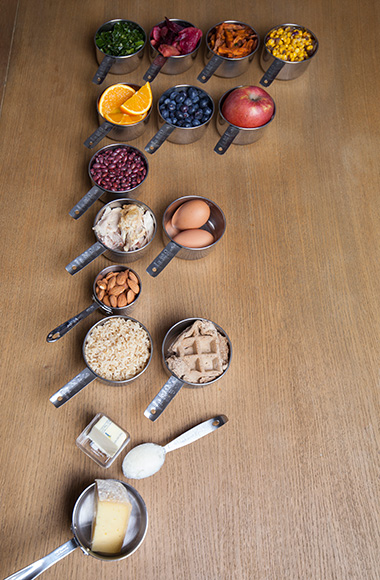
The following are cost-neutral foods (i.e., there is no change in quality points if eaten at or below recommended amounts):
•Black coffee (1 teaspoon honey okay, no other sweetener)
•Tea (1 teaspoon honey okay, no other sweetener)
•Sauces (soy sauce, sriracha sauce, ketchup, mustard)
•Vinaigrettes (balsamic, apple cider vinegar, lemon juice, olive oil, salt, pepper and spices)
•1 glass of wine, preferably red wine
•0.25 ounces dark chocolate (about 10 dark chocolate chips)
You lose a quality point for eating (or drinking) any of the following (e.g., if you ate one deduction from each category in one day, you would lose 8 quality points):
•Unhealthy grains such as white bread or white rice. This includes each sugary treat eaten. So eating three cookies gives you -3 points.
•Added sugar such as sugar added to tea, cereal, or other foods; sugar in the form of jelly, fruit preserves, or maple syrup; sugar substitutes like stevia or agave
•Processed foods (i.e., food that comes in packages)
•Food you can get as take out like at fast food restaurants
•Soda (including diet soda)
•Store-bought fruit juice
•Beer (12 ounces), each glass after the first glass of wine (5 ounces), or a cocktail or liquor (1.5 ounces)
•Chocolate other than dark chocolate such as milk chocolate or white chocolate, or more than 0.25 ounces of dark chocolate
Rule 1: Use a measuring cup. Be sure you are eating the right serving size.
Rule 2: For each of the food categories, you receive +1 point when you reach the recommended number of servings.
Rule 3: You have to eat a lot of vegetables. This one is usually the hardest point to score. It’s also the most important one to score!
•To get the veggie points, you have to eat the recommended number of servings or you get no points. In fact, you get no points if you eat less than the recommended number of servings of fruits and vegetables. It’s a make-it or break-it point system with no room for extra credit. For example, if you eat 4 cups of vegetables over the course of the day, you receive 1 point as long as at least one of those vegetables was a leafy green AND not more than 1 of those cups was from potato or corn.
•If you eat 5 or 6 cups of vegetables, (which we encourage you to do because it’s even better for your health), it still earns you the same point. On the other hand, if you eat 3 cups of vegetables that day, you receive no points. If you eat 4 cups of vegetables but none were green OR more than 1 was a potato, you get no points.
•When you eat 1 cup of leafy green veggies, circle the tally mark to make the veggie point qualifier easier to see when you calculate your food score at the end of the day.
Rule 4: There are categories of food like nuts and dairy where you are not allowed more than a certain serving size. This is because these foods are needed in a healthy, balanced diet, but only in lower amounts. If you do not eat these foods, you are missing out on some of the nutrients you need. If you eat more of these foods than recommended, you will fall short of your weight loss goals. This is why you receive a deduction (-1 point) if you eat more than the recommended amount.
•Step 1: Keep your journal with you at all times. Give yourself a tally mark for everything you eat based on its food category.
•Step 2: If you earned a deduction (-1 point), remember to mark those down as well.
•Step 3: At the end of the day, when you have no plans to eat or drink anything more, give yourself a check when you met or exceeded the goal for a given food category.
•Step 4: Add up the number of checks. This is equal to the total positive (+) quality points for the day.
•Step 5: Add up the number of (-) deductions you got.
•Step 6: Subtract the total deductions from the total of positive quality points. You’ve arrived at your food score.
Let’s look at a couple examples now. Compare the meal plans in the following tables to see how just a few bad food choices dramatically change your food score.
Download the following sheet for convenient use.
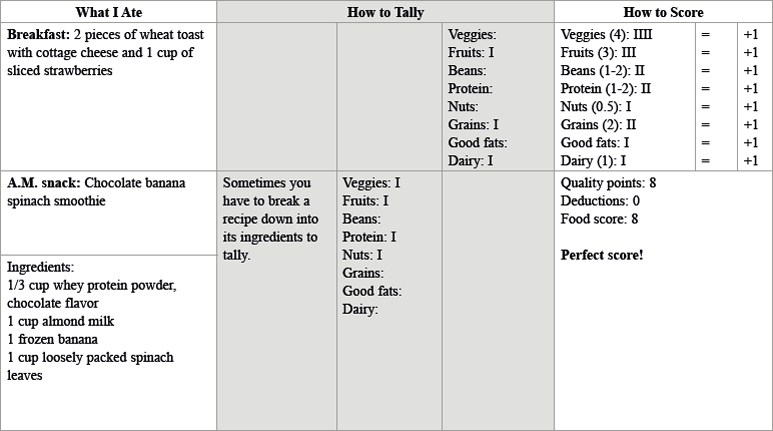
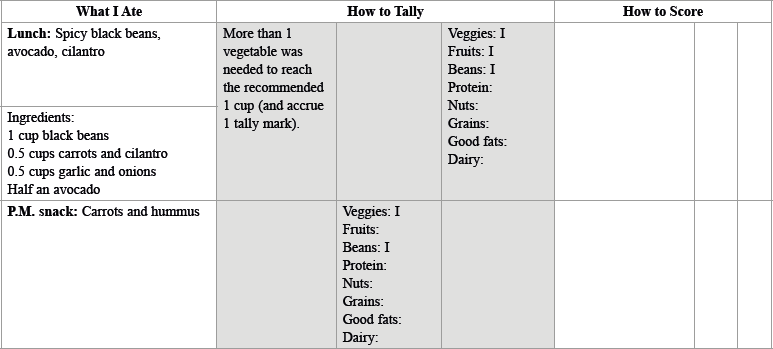
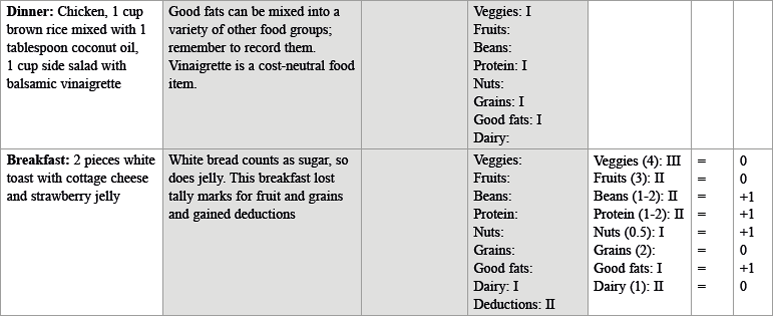



The food score represents diet quality as a number that ranges from -8 to +8. A score of -8 means you are likely not following any of the diet recommendations. You are mainly eating foods on the deductions list. A score of 0 means you are not eating enough healthy foods to outweigh the harm caused by eating unhealthy foods. A score of +8 is the best because it means you matched the recommended diet exactly.
Most women will find they need a food score of at least 5 to achieve sustainable, healthy weight loss of about 0.5 to 1 pound per week. For some women, even higher quality diets—scores of 6 and 7—will be needed to get weight loss results. Your journal asks you to track what you’re eating and give yourself a food score EVERY DAY so you can see what works for you.
For the average woman to maintain her weight, she needs to consume between 1600 and 1800 kcal daily. Women older than 50 need about 1600 kcal, while women between 30 and 49 need about 1800 kcal. To lose weight, stay healthy, and prevent diet-busting cravings which lead to overeating, we recommend eating about 1600 kcal daily while gradually increasing your activity level as prescribed in your training plan. This method will create the calorie deficit required to give you weight loss.
Research shows that most of us underestimate the number of calories we eat. Calorie counting is difficult and time consuming. This is why we recommend using a standard cup measure to decide how much of each food category to eat. In the next chapter, we also do the hard work of calorie counting for you by recommending specific meals and snacks based on 200 kcal to 400 kcal per meal.
For the purposes of calculating your food score, we distinguish between animal sources of protein (lean protein), plant sources of protein (beans and nuts), and milk sources of protein (dairy). Each source of protein has a place in a healthy diet. For example, tofu is from soybeans (a plant), so tofu should be tallied as a serving of beans in the food score. On the other hand, eggs come from fowl (animal), so even though eggs traditionally are thought of as a dairy product—and are found next to cheese and yogurt in the grocery store—in the food score, eggs count as lean protein. In the food score, the dairy category is regarded as milk-based products only.
One cup of fresh or frozen veggies is the same as 1/2 cup cooked veggies, and 1 cup of fresh or frozen fruit is the same as 1/4 cup dried fruit or 1/2 avocado. When eating baked goods such as a waffle or pancake, use the 1 cup measure for the wet batter to guess how many servings to count.

Yes, there are some foods and drinks that earn 0.5 points when eaten in common portions. You may find it helpful to record half points as dashed lines in your food journal. Make the line solid when you eat another 0.5-point portion.
•1 scoop (about 1/3 cup) protein powder is about the same as 0.5 point of lean protein
•1 cup of almond milk is about the same as 0.5 point of nuts
•1 cup of soy milk is about the same as 0.5 point of beans
•1 slice of whole-grain bread is about the same as 0.5 point of healthy grains
•1 egg is about the same as 0.5 point of lean protein
Alcohol can be enjoyable. Red wine in particular appears to provide some anti-aging benefits believed to be related to a chemical called reservitrol. However, problems with alcohol go under-recognized in our society. Women tend to under-report the amount of alcohol they drink and underestimate the amount of calories in alcoholic beverages. The key to good health, especially when weight loss is a goal, is to consume alcohol in low to moderate amounts with accurate judgment as to the amount in serving sizes. One serving of alcohol is 5 ounces of wine or 12 ounces of beer.
The Rx Eat does not allow for any amount of liquor, and one beer leads to a -1 point deduction.
Women should not consume more than 7 servings of alcohol in one week and never more than 3 servings in one sitting. Avoid getting drunk—it’s never good for you.
Eggs are a healthy, inexpensive source of protein. Egg yolks are high in cholesterol but do not seem to have much impact on blood cholesterol. You can see we recommend them in the diet as a cheap and healthy source of protein. If you have diabetes or high cholesterol, we recommend eating less than seven eggs in one week.
Red meat (e.g., steak, pork, venison, goat, salami, ham, sausage) is not part of the Mediterranean diet. You probably noticed that eating red meat hurts your food score. Because eating red meat has been linked to cancer, we actively discourage eating red meat. However, we understand some women have reasons of their own for eating protein in the form of red meat. Keep track of how much red meat you eat in your journal and realize that when you eat it, you get a deduction. If you are not reaching your weight loss goals, consider eating fewer portions or better yet, dropping it altogether.
Contrary to popular belief, recent studies are showing that full-fat dairy products may actually be good for your heart and circulation. They’re a good thing to have in a weight loss diet because they help you get the nutrients you need to stay healthy and feel more satisfied after a meal. In short, full-fat dairy helps you stick to your Rx Eat.
Healthy fats include olive oil, seed oils, and oils in fatty fish. Your brain, muscles, and joints need these fats to work well. The trouble is that fat is high in calories. That’s why the key to weight loss on a diet that includes fat is to eat healthy fats in small amounts. It may also surprise you to learn that butter does not seem to be as bad for your health as was once believed. If you like butter, go ahead and have a little bit. Just make sure to stay below the recommended 3 tablespoons of total fat per day.
Even if the soda claims zero calories, research shows women who drink diet soda often gain weight and suffer more heart attacks. The jury is still out as to the reasons for this. Some believe artificial sweeteners play a role. For now, suffice it to say—if the ancient Greeks didn’t drink it, neither should you.
Every meal, drink 8 to 10 ounces of water (a big glass) and make sure you drink at least that much between each meal so that every day you drink 6 to 8 glasses of water. You will know you are hydrated enough if you have to pee at least once every two hours or so. Most women find that to do this, they have to carry a re-useable water bottle in their purse and car.
If you don’t enjoy plain water, add a splash of fresh lime or lemon slices. You can also make a pitcher of water and toss in diced strawberries or cucumbers. Leave the pitcher in the refrigerator for a couple of hours or overnight to give the water flavor.
Black coffee and unsweetened tea are allowed in this diet and do not change the food score. Both coffee and tea are enjoyable, healthy parts of our own diets. One word of caution: be very careful if you choose to put honey into your drinks. Honey contains about 60kcal per tablespoon, so it’s easy to lose track of additional calories.
For someone who loves sweets, and is used to having a lot of sugar in her diet, it takes time to get used to a diet that allows only fruit and honey as sources of sweetness. Be patient with yourself. Remain determined. Know your taste buds can be encouraged to adjust to healthy eating and your palate can be changed. In the meantime, you might be able to soothe your sweet tooth by combining honey with fruit for utmost sweetness. For example, dip frozen grapes or bananas into a tablespoon of honey and enjoy this as a snack. Some flavored whey protein powders (like chocolate) are sweet and can be mixed into smoothies. You can also flavor sparkling water with fresh fruit like strawberries or oranges. A piece of dark chocolate and a glass of wine might do the trick (and won’t hurt your food score when enjoyed in small amounts).

Remember these four steps:
1.Choose foods from the list.
2.Record everything you eat.
3.Tally every time you eat.
4.Score and record your food for the day.
This might seem like a lot. Don’t get discouraged if your food score is not always perfect. Remember, aim for as high a score as you can get. The daily Rx includes the Rx Run-Walk and what you eat, which we call your Rx Eat. Think of your combined Rx Run-Walk and Rx Eat as one complete prescription for health. They work together and you need to follow both to get the results you want!
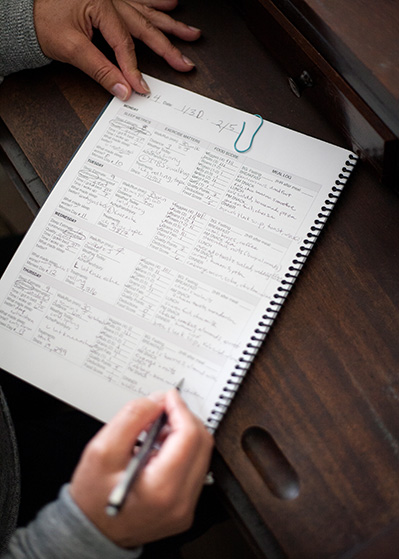
In the next section, let’s put it all together.
In chapter 3, you found the Rx Run-Walk that is right for you. Each of the Rx Run-Walk prescriptions has a matching Rx Eat that tells you how much food within each category of the Mediterranean diet you should eat and how often. The Rx Eat shows you what portion sizes should be based on how food looks on your dinner plate. Most women need to eat at least four times a day. Sometimes five small meals are better.
Consider this before you start:
1.Rx Eat assumes you do not have food allergies. For most women, the full Mediterranean diet consists of eight categories: vegetables, fruits, nuts, beans, whole grains, dairy, lean protein, and good fats. However, if you are allergic to a particular category like nuts or dairy, you will have to avoid it. In this case, your maximum food score will be adjusted to 7. The important thing for you is to watch carefully for a food score that helps you reach your health and weight loss goals.
2.Vegetarians are encouraged to substitute lean protein for eggs (if not vegan) or when not eating eggs; instead proportionately increase portions of the food categories which include protein such as beans, whey protein powder, nuts, and dairy. For example, if you do not eat eggs on a particular day, increase your serving of beans by 1 cup and add +2 to your food score when you’ve eaten 3 cups of beans. Alternatively, you could increase your serving of nuts by 0.5 cup and add +2 to your food score when you’ve eaten a total of 1 cup of nuts for the day.
3.If you have diabetes or pre-diabetes, Rx Eat assumes you partner with a nutritionist as you do the program.
Just like the Rx Run-Walk prescriptions, the Rx Eat prescriptions build upon one another. Let’s look at them now.
In the Rx Eat: Get Started prescription, you eat a total of about 1600 kcal daily divided into four meals. The food you choose should come from each of the eight categories in the assigned amounts. You calculate and record your food score daily, and aim for a score of 6 or better.

When combined with Rx Run-Walk: Get Started, Rx Eat: Get Started was created to help you lose about one pound every four weeks for a total of about 10 to 12 pounds in one year.

In the Rx Eat: Keep Going prescription, you eat a total of 1600 kcal daily divided into four meals. The food you choose should come from each of the eight categories in the assigned amounts. You calculate and record your food score daily, and aim for a score of 6 or better.
You’ll notice Rx Eat: Keep Going is identical to the Rx Eat: Get Started prescription. However, when you combine Rx Eat: Keep Going with the Rx Run-Walk: Keep Going prescription, you will lose about one pound every two weeks or so for a total of about 20 to 30 pounds in one year.
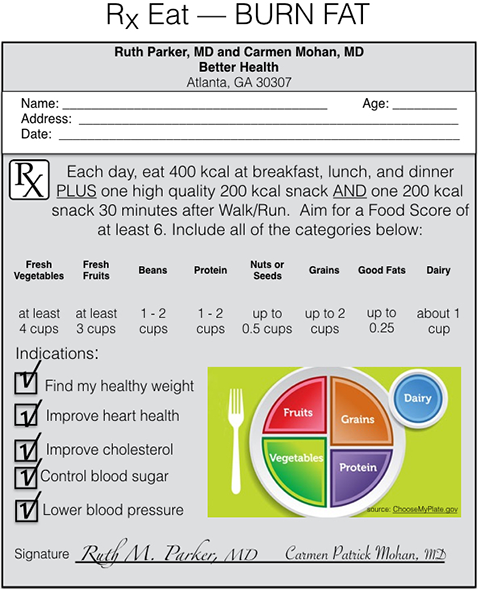
With the Rx Eat: Burn Fat prescription, you eat a total of 1600 kcal daily divided into five meals. The food you choose should come from each of the eight categories in the assigned amounts. You calculate and record your food score daily, aiming for a score of 6 or better.
The main difference between the Rx Eat: Burn Fat prescription and the other two programs is the addition of a post-workout snack—a snack to be eaten after your run-walk. Within 30 minutes to an hour after completing your Rx Run-Walk for the day, you should have a 200-kcal snack. Eating this way helps muscles recover from your run-walk, keeping them healthy and strong. The post-workout snack also encourages your body to use excess fat (instead of muscle) when it looks for fuel. You might also feel more energetic by eating more frequently. For all of these reasons, it is extremely important that you are consistent with the way you follow the Rx Eat: Burn Fat prescription.
When combined with the Rx Run-Walk: Burn Fat prescription, you will lose about one pound every week or so for a total of about 50 pounds in one year.
Avoid These Traps!
•Don’t strive for more weight loss than your program recommends. If you try to restrict the amount of food even more than what’s recommended, you will not get the nutrients you need to be healthy. You are also likely to feel hungry most of the time, leading to a miserable experience. Eating too little causes illness and injury. Trust the program and give your body the time it needs to adjust to your new lifestyle. Your goal is to work up to the full Rx Run-Walk and follow its Rx Eat for 30 weeks, then maintain that for at least 3 months. That is how you get the results in weight loss and better health.
•Don’t work out on days when you should be resting. Your body needs the rest days to build muscle and strengthen tendons. Over time, stronger, healthier muscles will help you lose weight.
•Don’t starve muscles by skipping recommended snacks after your run-walk. Thirty minutes to an hour after you run-walk is the best time for muscles to soak up nutrients. Skipping recommended snacks will lead to low energy, irritability, and weaker muscles.